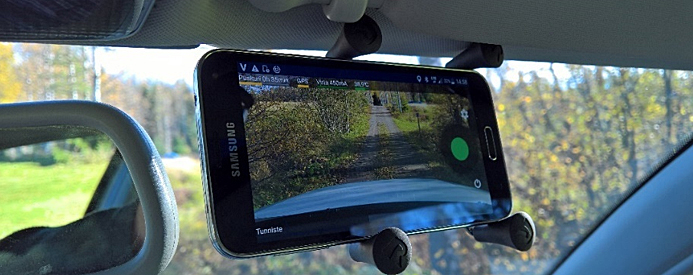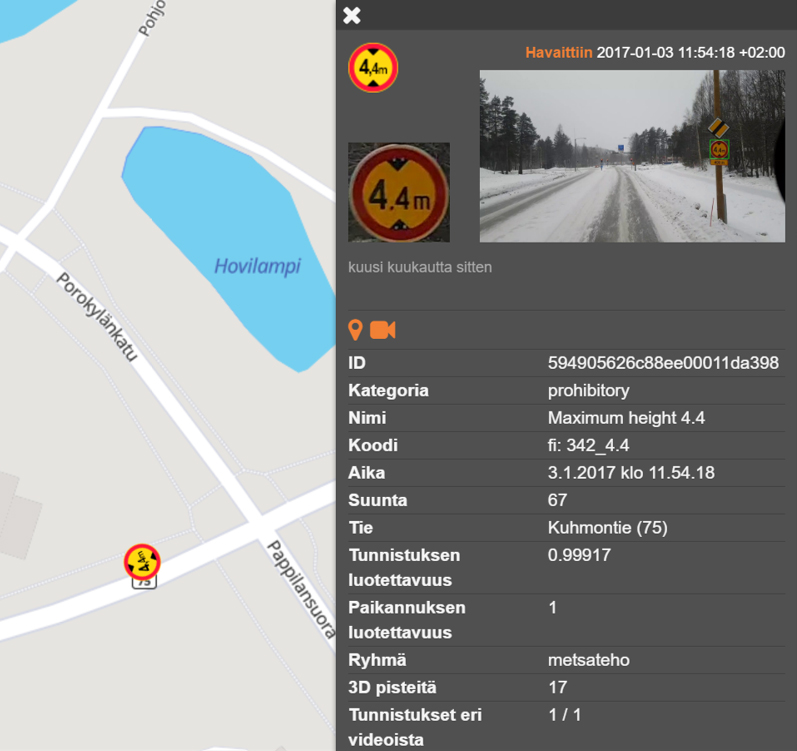Timber lorries to collect road data – the aim is to monitor the condition of minor roads

The digitalisation of the road network is often thought of as something related to main roads alone. The forest sector, however, is also interested in the road network outside main roads, and its condition will be monitored in many ways in the future.
Road data can already be easily collected by means of the mobile phone. With the appropriate application it is able to amass an astonishing variety of data.
The phone can be installed behind the windscreen of the timber lorry. In this way, road data could be collected by the very people who need it most.
The mobile phone can be used to video the road. ”You can then use machine vision software to determine the road width, the state of undergrowth along the road, the condition of traffic signs, or the presence of stones, dust, snow and ice on the road, or whether it is slippery,” says Pirjo Venäläinen, Senior Research Scientist at the Metsäteho research and development company. The video will show stones with a diameter of just three centimetres.
Practically every smart phone can monitor its own movements. Thus, it is able to provide data on how even the road is. And, thanks to its GPS system, all data can be automatically transmitted on to digital maps.
What is more, almost everyone has a phone. Anyone using a road can be a data collector.

Towards open data
Venäläinen knows of several existing projects to collect road data in Finland, though not that many collect data on minor roads, such as privately-owned and forestry roads. For the forest sector, however, these roads are essential, because they are used to transport timber from the forest to the industry.
Metsäteho aims at free access to as much of the data as possible, so that anyone could create new business on the basis of it. The network of minor roads is also needed for passenger and goods traffic, tanker lorries fetching milk from farms, tourism, trips to summer cottages, and other recreation.
However, the mobile phone is only one of the tools available for collecting road data. More exact data must be collected using more heavy-duty tools, such as laser scanners attached to vehicles.
”There are special traffic weather stations along the main roads. By attaching a monitoring unit to a vehicle, we could turn it into a mobile weather station,” says Venäläinen.
Such units are expensive, but the number needed would not be that great. ”They could be used to see below the road surface, which is essential if you are planning to completely renovate a road. You can also use them to double-check the data collected by mobile phones,” says Venäläinen.
Data collation takes a lot of work
Data can also be collected by means of satellites, aerial photography and remote-controlled drones. ”We also study data from the lorry itself, such as the use of brakes and the ABS system. And we use smart tyres that collect data,” says Venäläinen.
Still, all data is useless unless it is moved on for further use or processing. Real-time data can be sent on to other road users immediately – about animals on the road, for example.
A larger project will be to create a service platform where data from different sources is brought together and collated. This has been under construction at the Finnish Forest Centre for the past year.
”At the moment, we have interviewed possible users of the platform. The technical specifications will be completed this year,” says Seppo Niskanen, Chief of Business at the Forest Centre.
The platform will monitor data quality, and also collate and ultimately publish it. Collating the data from different sources brings the greatest benefits, but is also a lot of work, as there are so many, and so many different actors in traffic. ”One of biggest challenges is standardising the data,” says Niskanen.
The platform would be accessible to all road users, but also to those who maintain the road. It would show, for example, what types of vehicles have access to a road during normal conditions or the mud season, where snow removal is needed or where a culvert might have to be repaired.
Thanks to the on-line platform, visiting a road to inspect its conditions would become unnecessary, which would bring in significant savings.

Driver is in key position
As far as collecting data by means of timber lorries is concerned, the driver is in a key position. About a hundred workers connected to timber transport have been involved in pilot studies by Metsäteho. Their attitude towards the project has mainly been positive.
”Of course, the suspicion has been voiced that the studies are actually about monitoring the performance of the drivers, but it has been easy to dispel that thanks to the technical solutions adopted. You don’t, for instance, have to transmit all data real-time, but can collect a bigger batch and send it on at intervals,” says Venäläinen.
Collecting and sending on the data should be automatic, so that there is no additional need for the driver to key in anything. Another question to resolve is what data will be published anonymously and the extent to which the data collector can decide about access to it.
”These are important issues. We plan to set up a special task group to deliberate the rules for using vehicle data,” says Venäläinen. Data protection also interests companies and the managers of private roads.
On the other hand, the need for road data is understood everywhere. One of the contributing factors is climate change, which is likely to make road conditions more variable.
Niskanen anticipates that the new platform will be operational in the beginning of 2020, if everything goes according to plans.
Previously in forest.fi: Great leap in efficiency of Finnish wood supply system

Kirjoita kommentti